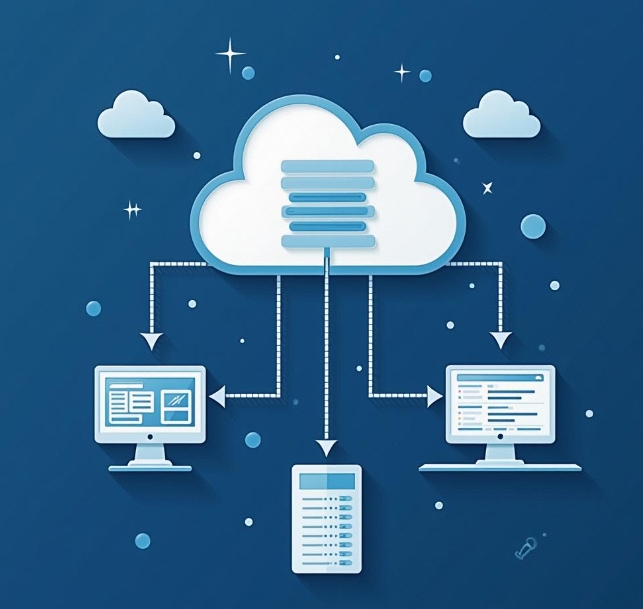Cloud Computing Applications in E-commerce Development: Enhancing Performance and Scalability
- latest articles
- 1.DApp Development & Customization: Merging Diverse Market Needs with User Experience 2.Analysis of the Core Technical System in DApp Project Development 3.How to achieve cross-chain interoperability in Web3 projects? 4.How does the tokenization of points reconstruct the e-commerce ecosystem? 5.How to Set and Track Data Metrics for a Points Mall? 6.What is DApp Development? Core Concepts and Technical Analysis 7.Inventory of commonly used Web3 development tools and usage tips 8.Development of a Distribution System Integrated with Social E-commerce 9.Six Key Steps for Businesses to Build a Points Mall System 10.What is DApp Development? A Comprehensive Guide from Concept to Implementation
- Popular Articles
- 1.Future Trends and Technology Predictions for APP Development in 2025 2.Analysis of the DeFi Ecosystem: How Developers Can Participate in Decentralized Finance Innovation 3.From Zero to One: How PI Mall Revolutionizes the Traditional E-commerce Model 4.DAPP Development | Best Practices for Professional Customization and Rapid Launch 5.Recommended by the Web3 developer community: the most noteworthy forums and resources 6.From Cloud Computing to Computing Power Leasing: Building a Flexible and Scalable Computing Resource Platform 7.How to Develop a Successful Douyin Mini Program: Technical Architecture and Best Practices 8.Shared Bike System APP: The Convenient Choice in the Era of Smart Travel 9.How to Create a Successful Dating App: From Needs Analysis to User Experience Design 10.From Design to Development: The Complete Process of Bringing an APP Idea to Life
In today's digital era, e-commerce has become a vital component of the global economy. With the continuous advancement of internet technology and the growing demands of consumers, mall development faces unprecedented challenges. How to provide a smooth user experience under high-traffic, high-concurrency conditions, how to handle massive amounts of data, and how to ensure system stability and security have become urgent issues for mall developers. Cloud computing, as a revolutionary technology, has been widely adopted in mall development due to its exceptional performance, flexible scalability, and cost advantages.
This article will explore the application of cloud computing in mall development, focusing on how it enhances performance and scalability, and will demonstrate the specific advantages and practical value of cloud computing technology in mall development through case studies.
I. Overview of Cloud Computing
Cloud Computing is an internet-based computing model that provides computing resources (such as servers, storage, databases, networking, software, etc.) as services over the internet. These services are typically billed on a pay-as-you-go basis, allowing users to flexibly select computing resources according to their needs without worrying about the maintenance and management of underlying hardware infrastructure.
The core advantages of cloud computing lie in its elasticity, flexibility, and pay-per-use characteristics. For mall development, the high availability, elastic scaling, and globally distributed service capabilities provided by cloud computing enable rapid resource expansion in the face of sudden traffic surges and massive data, thereby enhancing system performance and scalability.
II. Applications of Cloud Computing in Mall Development
Mall development involves multiple modules, including product display, user account management, shopping cart, order processing, payment systems, and logistics management. Each module may face different performance requirements and scalability needs, and cloud computing can provide strong support in the following areas:
1. Enhancing System Performance
In mall development, system performance is one of the core aspects of user experience. When users browse products, place orders, make payments, or check order statuses, they expect the system to respond quickly and operate smoothly. Especially during peak periods such as promotional events or holidays, mall systems need to handle high concurrent access from various sources.
Cloud computing can enhance system performance in the following ways:
Load Balancing: Cloud computing platforms typically offer load balancing services that distribute user requests evenly across multiple servers, preventing any single server from becoming overloaded. Through load balancing, mall systems can efficiently handle a large number of concurrent requests, ensuring a smooth shopping experience for users even under high traffic conditions.
Content Delivery Network (CDN): CDN technology caches static resources (such as images, videos, stylesheets, scripts, etc.) on multiple distributed nodes, reducing the physical distance between users and servers, thereby improving website loading speed. Globally, users can load mall pages at the fastest speed regardless of their location, enhancing the user experience.
Database Optimization: Mall systems often handle vast amounts of data, including product data, user data, order data, etc. Cloud computing platforms can provide high-performance database services and support automatic scaling and sharding of databases. Under high concurrency, cloud databases can distribute data requests, reducing the pressure on a single database and thereby improving query efficiency and response speed.
2. Achieving Elastic Scalability of the System
As mall businesses continue to grow, the load pressure on the system gradually increases. Traditional server architectures often struggle to cope with sudden traffic spikes, and scaling can be costly. Cloud computing, however, offers extremely flexible scalability for mall development.
Automatic Elastic Scaling: The elastic scaling services provided by cloud computing platforms can automatically adjust resources based on actual traffic. When a mall system faces a surge in traffic, the cloud computing platform can quickly increase computing resources; when traffic decreases, the system can automatically reduce resources, achieving efficient resource utilization. This automated scaling mechanism allows mall systems to flexibly respond to various changes and avoid resource wastage.
Distributed Architecture: Cloud computing supports distributed computing and storage, enabling mall systems to distribute the load of different modules across multiple servers, thereby improving overall system performance and reliability. Through distributed architecture, mall developers can easily scale the system to meet growing business demands.
3. Data Security and Disaster Recovery Capabilities
For mall development, data security and system high availability are crucial. Cloud computing platforms typically provide high-standard data encryption, backup, and recovery services to ensure the security and integrity of mall data.
Data Encryption and Backup: Cloud computing platforms support encrypted storage of sensitive data in mall systems and provide regular backup services. Even in the event of system failures or hacker attacks, mall data can be effectively protected, ensuring it is not lost or leaked.
Disaster Recovery and High Availability: Through multi-node and multi-region deployments, cloud computing platforms can achieve high system availability. If a node or region fails, the system can automatically switch to backup nodes or regions, ensuring the continuity of the mall system. This disaster recovery mechanism allows malls to remain operational under any circumstances, minimizing losses caused by system downtime.
4. Cost Efficiency
The pay-as-you-go model of cloud computing allows mall developers to choose appropriate resources based on actual needs. Compared to traditional self-built servers, cloud computing can effectively reduce the initial investment and ongoing maintenance costs of mall development.
Pay-as-You-Go: Cloud computing platforms typically offer usage-based billing, where mall developers only pay for the computing resources, storage space, etc., that they actually use. This flexible payment method enables malls to dynamically adjust resource configurations based on traffic and business needs, avoiding fixed resource wastage.
Reduced Infrastructure Investment: In traditional development models, mall enterprises need to purchase and maintain a large amount of hardware equipment, investing significant funds in infrastructure construction. Cloud computing platforms, however, provide fully managed infrastructure services, allowing developers to avoid managing hardware facilities themselves and reducing operational costs.
III. Case Study: How Cloud Computing Helps Malls Enhance Performance and Scalability
Let's examine a specific case to understand the practical application of cloud computing in mall development.
Case: Cloud Computing Application in a Large E-commerce Platform
During the "Double Eleven" promotional event, a large e-commerce platform faced significant challenges with high concurrent access and transactions. To ensure system stability and user shopping experience, the platform deployed various optimization measures through a cloud computing platform.
Load Balancing: The platform used the load balancing service provided by cloud computing to distribute user requests across multiple server nodes, avoiding overload on any single server. Through intelligent scheduling, the system could automatically assess server load conditions and optimize resource allocation.
Automatic Elastic Scaling: During the peak promotional period, the e-commerce platform experienced a surge in traffic. The cloud computing platform automatically activated elastic scaling, increasing computing resources to ensure the mall system could run smoothly under high concurrency. As traffic gradually decreased, the system automatically scaled down resources, reducing costs.
Global CDN Acceleration: To improve access speed for global users, the platform deployed multiple CDN nodes through the cloud computing service provider, caching static resources closer to users, shortening page loading times, and enhancing the shopping experience for global users.
Database Sharding and Backup: The e-commerce platform implemented automatic sharding and data backup through cloud databases. When data request volumes surged, the cloud database could intelligently distribute query loads, improving response speed. Additionally, the platform set up regular backups to ensure data security and integrity.
Through the application of these cloud computing technologies, the e-commerce platform successfully addressed the challenges of high concurrency and high traffic, achieving efficient operation and stability assurance for the system.
IV. Summary and Outlook
The application of cloud computing in mall development has significantly enhanced the performance and scalability of mall systems. Through technologies such as load balancing, elastic scaling, CDN acceleration, and database optimization, malls can maintain excellent performance in high-concurrency, high-traffic environments and flexibly respond to various business needs. Furthermore, cloud computing ensures the stable operation of mall systems by providing high security and disaster recovery capabilities.
-

How does the tokenization of points reconstruct the e-commerce ecosystem?
With the continuous advancement of internet technology and the gradual prolifera···
-

How to Set and Track Data Metrics for a Points Mall?
With the rapid development of the e-commerce industry, points malls, as a common···
-

Development of a Distribution System Integrated with Social E-commerce
With the rapid development of internet technology, the e-commerce industry has e···

 Blockchain
Blockchain












